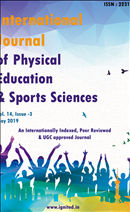A Research on Anthropometric Characteristics and Motor Fitness Components of School Going Students Comparative Analysis of Anthropometric Characteristics and Motor Fitness Components in School Students
Main Article Content
Authors
Abstract
Physical fitness is an important marker of health that enables people to carry out activities of daily living with vigour and alertness but without undue fatigue and with sufficient reserve to enjoy active leisure pursuits and to meet unforeseen emergencies. Especially, due to scientific findings that the onset of civilization diseases (e.g., obesity, cardiovascular disease) begins in childhood and that physical fitness tracks (at least) into young adulthood, the regular monitoring and promotion of physical fitness in children is risen up to a public health issue. In relation to the evaluation of a child’s physical fitness over time (i.e., development) the use of longitudinally-based percentile values is of particular interest due to their underlined dedication of true physical fitness development within subjects. The purpose of the present study was to compare the selected anthropometric and motor fitness variables namely Height, Weight, Body Mass Index (BMI), Speed, Agility, Explosive strength and Cardio-respiratory endurance (VO2max) between Secondary and Higher Secondary level Students. The study was conducted on 60 school level male students [30 Secondary level Students and 30Higher Secondary level Students]. They were randomly selected from Kendriya Vidyalaya, M.G. Railway Colony, Bangalore. The age of subjects ranged between 14-18 years. In the present study Height, Weight, BMI, Speed, Agility, Explosive strength and Cardio-respiratory Endurance (VO2max) were chosen as the variables for the study. All the variables were measured using standard tests. Descriptive Statistics and independent t-test were used to calculate the data. The result of the study showed that there was significant difference between Secondary and Higher Secondary level Students in comparison to their Height, Weight, B.M.I, explosive strength and VO2max.
Downloads
Download data is not yet available.
Article Details
Section
Articles

